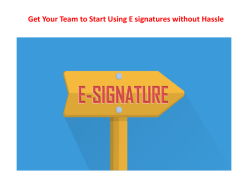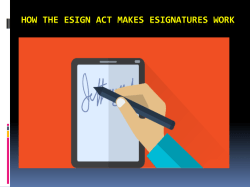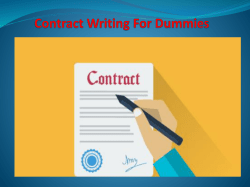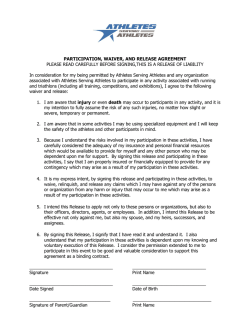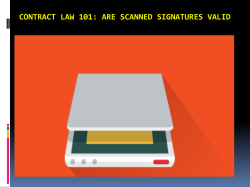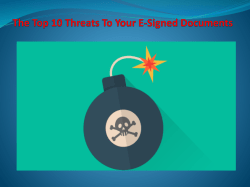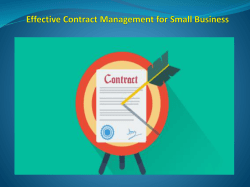
E contracts 101 - The Beginners Guide to Contract Law
E CONTRACTS 101: THE BEGINNERS GUIDE TO CONTRACT LAW There have been two times in my career where misapplied or changed signatures and contracts have led to serious consequences. Let me tell you those stories briefly, to get you in the mood for a bit of contract law. In the 1990s, my partner and I decided to setup our own software company. We were total novices; we had never setup a company before. Soon after we found a third party who offered to resell our product for us. This seemed like a great idea. They had sales experience; we had a product, what could go wrong. A year later, we were in court, battling for the rights to our own product. The reseller turned out to be, less than honest. They had tricked my partner into signing a contract, which gave them, ‘world-wide and exclusive rights’ to our product. I had no sight of the contract and my partner, a software developer, wasn’t very savvy about these things (I am shaking my head as I write). The end result was a cost of over $160,000 in court costs. We did win our case, but we almost lost our company, the court placing an embargo on sales until the matter was resolved. The second contract debacle happened a few years later to a colleague. He was the CTO of a small software house. This software company was taken over by a larger company. He duly signed the merger contract, which at that time had no stipulations over intellectual property (IP) ownership as they were developing new products. Subsequently, one of the original products became a killer app. The merger company then attempted to take the original product copyright. They attempted to do this by copy and pasting in IP ownership clauses into the contract. This came out in a court case over IP. To all intents and purposes, it looked like my colleague had signed a much larger scope of clauses, handing over IP from his original company. It was only after forensic analysis of the contract and a court case that the added clauses were revealed as fake. Again, the case was won, but at a massive cost and in the end, the entire company went into liquidation. Elements of an E contract in Contract Law When you do any business deal, it is always a good idea to get an agreement of the various terms in writing. Contracts can be verbal or in the form of a deed too. The contract forms a promise. This usually means that one or both sides will receive some sort of remit as part of the obligations in the contract; you scratch my back and I’ll scratch yours. The obligations are enforceable by law. So if you renege on any of those obligations, you can be taken to court and be dealt with. This is what happened in my cases above, but going to court should always be the last option. In 1988, the U.S. became a member of the ‘United Nations Convention on Contracts for the Sale of Goods’. This overriding structure governs the execution of contract law (warning, good nighttime reading for insomniacs). E contracts are digital versions of the old paper contracts The same essential laws govern them. The parts of a binding contract, both e contract and paper, that are vital, are: Offer: This is the promise between the parties. So for example, company X will develop company Y’s web application; company Y will own the intellectual property, and will pay company X $5,000 for this work. The offer then needs to be accepted. So, in the example above company Y will accept that they will pay $5,000 (usually with a timescale set). Company X will develop the site and make no claims at that time, or in the future, for the intellectual property generated during development. Acceptance: This is where both parties accept the terms of the offer using some form of communication. An offer isn’t automatically accepted just because you haven’t expressively rejected it. It’s not quite as simple as that (is the legal system, ever). There are variants around acceptance. A unilateral contract has an acceptance based on the performance or non-performance of a task. Bilateral contracts are only accepted once the promise of the contract has been enacted by both sides. It gets trickier when you have a situation where someone accepts a specification that isn’t exactly what they wanted, pays for it, then realizes it is wrong. Their payment promise means they have effectively accepted the contract, which is now complete, even if it isn’t what they hoped for. Consideration: The consideration of a contract is the items of value that the contract revolves around. In the example of company X and Y above those considerations are software code, IP, and monies. Mutuality of Obligation: This is related to the promises made in the contract. You should set out the expectations of the promise delivery, to avoid ambiguity around performance and subsequent invalidation of a contract. Mutuality of obligation is becoming a contentious area, especially in employment and contractor contracts. A case involving a Stringfellows nightclub dancer shows how complex this element of a contract can be. Legal competency and capacity: This sets out the legal status of the persons who are entering into the contract. Certain persons are deemed as being unable to give clear consent. Typically this would include minors, bankrupts, mentally incapacitated or intoxicated people. This element is to protect those people from entering into something, legally binding that they may not understand. Writing requirement: Almost every U.S. state has created legislature, which requires that certain contracts must be in writing (this includes e contract form) to be legal. It is known as the ‘statute of frauds’ and the basic argument is, it’s always best to get it in writing. In terms of freelance or contractor contracts, anything over $500 really needs to be in writing to be legally enforceable. Once you have all of these elements in place, you have a legally binding contract. Creating a watertight contract does not have to be difficult. Here are a few tips to make sure you get it right first time and avoid your day in court: Be prepared Firstly, you will often find that you can re-use the same basic contract structure for each new client. You may make a few minor changes, but the important clauses, such as termination clauses, often remain the same. Using a lawyer to create a robust contract in the first instance means that future contracts can be based on this template. Digital signature portals, like the ApproveMe system, work with the concept of contract templates for this very reason. Make sure all stakeholders have read the contract Once you have your contract, make sure every signatory of the contract has read it thoroughly and understands the implications of the promises and other clauses. They will be agreeing to them when they add their signature. Again, ApproveMe helps with this process by entering the contract in a document management control system. Have all stakeholders sign the contract If you are using an e contract system, like ApproveMe, you can make sure this part of the process is streamlined. The e contract is sent to each stakeholder, who in turn authenticates that ‘they are who they say they are’, before adding their e signature on the contract. If and when it comes to the time that the contract is to end, or worse, you have a contract breach, you will have documentary evidence in the form of audit trails and even revoked signatures, showing who saw the contract and agreed, on both sides. If you do end up in court, having an ESIGN compliant e signature on an e contract will make the process much easier and therefore much cheaper. Laws like ESIGN and UETA mean that correctly applied digital signatures carry the same weight as traditional pen and ink signatures. Electronic signature, technology, however can go one step further and create fully audited trails of document access, signing, and agreement. It even protects those all-important clauses from abuse. One rock solid contract.. Having an electronic signing process in place with a legally binding contract adds a technological barrier to any contract shenanigans, like I described above. In those cases, both could have been prevented altogether using e contracts with e signatures based on firm contract law. Today, contracts can be created that are fully audited with built in non-repudiation of e signatures, i.e. the e-signatures are binding and tied to the very content of the document. If any changes are made, they instantly invalidate the e-signature and the signatories are alerted. There is no way that the two cases above could have occurred if an electronic contract and an electronic signing process had been followed. In the first case, as the director of the company I’d have been alerted to the contract creation and signing event as I could tie contracts into my document management processes. In the second case, my colleague would have been alerted to the contractual clause changes, the signatures would also have been invalided, voiding the contract . E signature laws like ESIGN give us the tools to make sure that even e contracts can be fully enforced under contract law. To make sure your contracts are enforceable and unable to be manipulated, check out our ApproveMe E-signature WordPress Plugin. Article Resource: https://www.approveme.com/e-signature/e-contracts-101beginners-guide-contract-law/
© Copyright 2025
